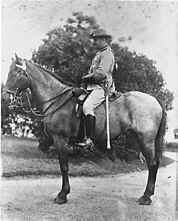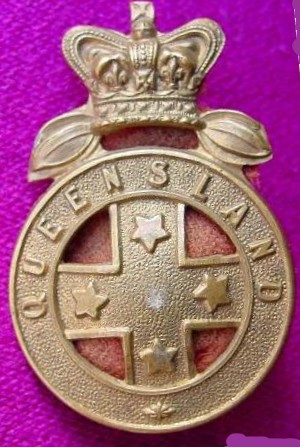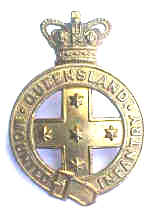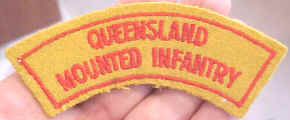|

|
| Category: Assorted/Heroes |

|
|
|
|
|
|
Colonel
Percy Ralph Ricardo, C.B. "The Father of QMI" |
 |
South Africa, c. 1900. An
informal group portrait of British and Australian Army officers, include
a number of officers of the 1st Queensland Mounted Infantry
Contingent.
The twelve officers in this group
wearing bush hats with light coloured puggarees and Emu feather plumes
are thought to be officers of the 1st Queensland Mounted Infantry. |
| Identified
in the group are: sitting on a chair on the right holding a rifle,
Lieutenant Colonel (Lt Col) Percy Ralph Ricardo, who commanded the 1st
Queensland Mounted Infantry; the officer squatting on Lt Col Ricardo's
left, and also holding a rifle, is Captain (Capt) Henry (Harry) George
Chauvel, who commanded A Company until he was appointed Adjutant on 13
February 1900 and the officer standing 7th from the left is Capt Joseph
Espie Dods, Army Medical Corps and Surgeon to the 1st Queensland Mounted
Infantry.
The names of the other officers from
the 1st Queensland Mounted Infantry who could be in the photograph are:
Lieutenant (Lt) Cecil Henry Anderson-Pelham, Capt Reginald Spence Brown,
Lt David Elder Reid, Lt Thomas William
Glasgow, Lt Charles Alexander
Cumming, Lt Alfred George Adie, Capt Philip William Grant Pinnock, Lt
Richard Dowse, Lt Henry Bailey, Lt Robert Gordon and Lt Cecil Herbert
Black. (Donor J. E. Dods) |
|
Also
see Allied leaders of the Boer War |
|
This
article is from a Melbourne weekly publication “The Australasian’,
dated 8th June 1907.
 |
HUNTING
ACCIDENT. COLONEL
RICARDO KILLED.
While
hunting with the Melbourne Hounds on Monday, Colonel Ricardo, the
Victorian military commandant, was thrown from his horse, and
sustained a fracture of the base of his skull through striking a
stump with his head.
The
accident occurred in good country, a short distance out from
Lyndhurst. |
Colonel
Ricardo was riding a big horse belonging to Lieut-Colonel Johnston, which
was well up to his weight, and a clever jumper.
Shortly after negotiating a stiff jump, Colonel was seen to sway
about in his saddle. Appearing
to lose control of his horse, he bumped into Mr. H. W. Riggall’s mount,
and then went on, still rolling about in the saddle.
Before
anything could be done, he fell over the horse’s shoulder.
A spring cart was obtained, and the sufferer removed to Lyndhurst
railway station, where Dr. Rose gave temporary aid.
The unconscious man was afterwards conveyed to Melbourne by train,
and taken to Miss Garlick’s private hospital, under the care of Colonel
Ryan, P. M. O. No hope was
entertained for his recovery from the first, and he died on Tuesday
evening.
A
VARIED CAREER.
Colonel
Percy Ralph Ricadro, C.B., was the son of the late Henry Ricardo, of
Weston Bath, England, and was educated at Cheltenham College.
When little more than a boy he enlisted in the Royal Horse
Artillery, and went out as a driver in Lord Wolseley’s Red River
expedition to Canada in 1870. Lord
Wolseley had four six-pounder steel rifle-guns, and two of these he used
as a field battery under Lieutenant J. Alleyne.
Young Ricardo was one of Lieutenant Alleyne’s best drivers.
He returned to England, and obtained his discharge.
Then, after a few years spent near Bath, mostly occupied in hunting
and driving – for he was an equally fine horseman and whip – he came
to Australia to seek his fortune.
On
arrival in Australia he worked for some time at a variety of occupations.
He was a superb axeman, and in fact was a master of all kinds of
manual work. Woodcarving and
carpentry were always his hobbies, but he was an equally fine blacksmith.
It was no doubt during these early years in Australia that he made
himself expert in so many different vocations.
He had been taught to draw at school, and was all his life a fine
draughtsman. For a time in
Sydney he practiced as an architect, and several of Sydney’s buildings
were erected on his designs.
But
he soon tired of city life, and went off to the Queensland cattle country.
There he obtained colonial experience as a jackeroo, and soon rose
to be manager of Franklinvale Station.
But the long drought of the early eighties drove him out of this,
and he became manager of the City Ice Works, in Brisbane.
It was while there that he organized the Queensland Mounted
Infantry.
 |

The QMI badge varied
over the years. There was a 4 star version (left) and a 5 star version
(above). As well, later, there were many Regiments that used the name
including the 2/14 QMI. 
|
|

|
It
is by this body – known all over Australia and South Africa as the
Q.M.I. – that Colonel Ricardo will be longest remembered.
It was his own creation. The
first corps was formed in Brisbane, and was 130 strong.
That was February, 1885, and on February 24 that year
Mr. Ricardo was gazetted as Lieutenant.
He was made a Captain on June 16, 1888, and in the following April
raised to the rank of Major.
The
Q.M.I. by this time had increased to two full regiments, and became an
important branch of the service, with Colonel Patterson as commanding
officer. It was about 1889
that Major Ricardo went to England for a year.
He went at his own expense, but became attached to a mounted
regiment at home, and amassed a lot of useful information, to be used for
the benefit of his mounted infantry when he returned.
When
the South African War broke out the Queensland Mounted Infantry were the
first troops offered to the British Government, and it was at the
suggestion of Lieut-Colonel Ricardo – he had got his step on March 8,
1897 – that this offer was made. He
led the first contingent of Queensland Mounted Infantry to Africa, and
they were the first Australian troops to get into action.
That was at Sunnyside, and the Prince of Wales, who is now King,
telegraphed his congratulations to Lieut-Colonel Ricardo.
After the war he was appointed military commandant of Western
Australia, and given the temporary rank of Colonel.
In 1905 he was given the post of Military Commandant of Victoria.
 |
| Colonel
Ricardo, probably when he was Military Commandant of Victoria circa
1905 |
Colonel
Ricardo was always liked by his men.
The cattlemen and the boundary riders, who made up the bulk of the
Queensland Mounted Infantry, were amongst his most enthusiastic admirers,
and the news of his death will bring sorrow to many a bush hut and station
barracks in the cattle country.
The
late commandant was twice married. By
his first wife he had two children – a daughter, who is herself married,
and a son now doing an engineering course in London.
His second wife, who survives him, is a daughter of Colonel
Thompson, principal medical officer of Queensland.
She has two daughters.
THE
FUNERAL.
The
remains of the late Colonel Ricardo were interred in the Boroondara
Cemetery on Thursday afternoon with all the ceremonial of a military
funeral. Although no official
parade could be arranged, there was a splendid voluntary muster of troops.
Altogether, 800 men odd all ranks paraded at Victoria Barracks.
The
various corps were formed up along the western side of St. Kilda road –
the Victorian Rifles and the Victorian Scottish being in the front, and
the other corps behind them in order of seniority, finishing with a
detachment of sailor-hatted blue jackets from H.M.S. Psyche.
Behind them were the officers of the various corps, again in order
of seniority, with the late commandant’s staff last.
At a quarter-past 3 o’clock the solemn strains of the R.A.A.
Band, under Lieutenant Riley, playing the “Dead March in Saul,”
announced to the waiting troops that the gun-carriage and escort had moved
off. The men were called to
attention, and the cortege came down past them to take its place at the
head of the column.
It
was an imposing spectacle. First
came the men of the R.A.A. and Permanent Engineers in blue and scarlet
uniforms. They were in full
dress, their rifles carried at the reverse.
Their slow marching was perfect.
Behind them marched the band, with drums muffled in black, followed
by a carriage, in which were seated Major Sadleir, military chaplain; and
the Rev. Archdeacon Hindley. Next
came Major Dangar, riding at the head of the six gun horses drawing the
gun carriage, on which rested the coffin.
The
khaki harness of the horses was laced with white ribbon.
The coffin was draped with the Union Jack, on top of which were the
dead officer’s sword-belt, sword, and plumed helmet.
Round the gilded handle of the sword clustered a modest wreath of
dark red roses, with streamers of khaki and maroon.
It was the last tribute of the Queensland cattlemen to their old
commander – the father of the Q.M.I.
To the dark red roses was attached a pathetic little message.
It read :-
Behind
the gun-carriage was led “Carnage,” the late commander’s favourite
charger. The reins were laced
with white ribbon; while in the stirrups were strapped a pair of empty
jack-boots, the spurred heels facing to the front.
Two floral cars laden with splendid wreaths followed.
Then came the troops, and behind them a string of carriages and
cabs, and one motor car.
As
the long procession passed along Flinders-street the band was playing the
German “Dead March,” while a bell in the Cathedral belfry tolled at
intervals; as soon as the city had been passed the procession proceeded at
the quick march until just outside the cemetery.
There the escort and band lined the entrance, while the rest of the
cortege marched through. It
was then 5 o’clock. The
march had taken an hour and three-quarters.
The
funeral service was short and impressive.
As the last sound of the clergyman’s voice died away, Major
Clark’s sharp command was heard, “Present!”
“Fire.” Three
times, with a muttering roll of the drums, the final salute volleyed out,
and then the trumpets wailed out the “Last Post.”
Among
those at the funeral were Colonel Tunbridge, who represented His
Excellency the Governor-General, and Lieutenant Guy Madden, representing
His Excellency the Lieutenant Governor (Sir John Madden).
His excellency Sir George Le Hunte, Governor of South Australia,
had sent a special representative, (Captain Connor.
The Inspector-General (Major-General Hoad) was represented by
Captain C. Campbell. The
Acting Prime Minister (Sir John Forrest) drove out with the Minister of
Defence (Mr. Ewing) and the Minister of Home Affairs (Senator
Keating).
This
article was copied from Florence Lyall’s scrapbook.
Colonel Ricardo married William Lyall’s daughter, Annabella
(Bella) at Harewood in 1879. Bella
died at the family home ‘Wyandra,’ Bowen Hills, Brisbane, in 1895. |
|